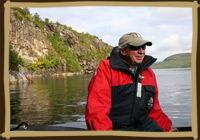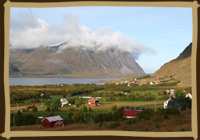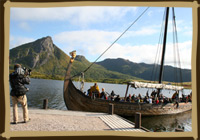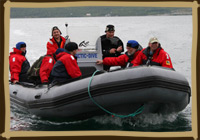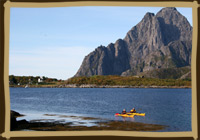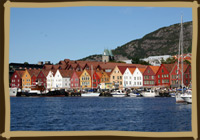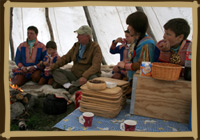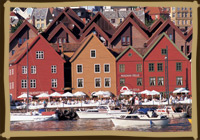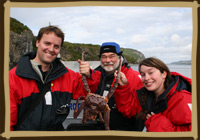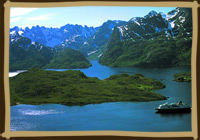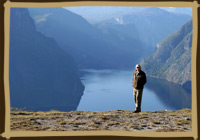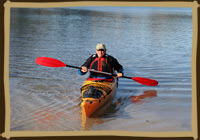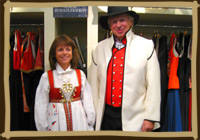
Richard on-camera: A thousand years ago Vikings set out from these Fjords striking fear across Europe. Yet today this ruggedly beautiful country is the home of the Nobel Peace Center, of explorers and adventure travelers and one of the most eco-friendly countries on earth. How could such a progressive nation grow from such violent past? Is modern Norway a result of its Viking heritage or a reaction to it?
Richard voice-over: Join me as I travel the length of Norway from its magnetic Arctic north, its wild serrated sea coast and its pulsing modern cities in search of the Viking Spirit.
R VO: In the year 793 long ships with dragon headed bows and square sails crossed the North Sea and landed on England’s shore. According to the Anglo-Saxon Chronicle “The ravages of heathen men miserably destroyed God’s church on Lindesfarne,” and ever since the name Viking has been synonymous with pirates, violence and terror.
R VO: Norwegians today are active in peace and conflict resolution. Norwegian women have among the highest participation rates in politics and in gender equality issues around the world. Besides successful environmental efforts at home, Norwegians are vigorously involved in stewarding ecological solutions in developing countries.
R VO: So why does there seem to be such a discrepancy between the ancient stereotype of the plundering, pillaging raider and modern, civilized Norway? The Viking age ended over a thousand years ago, why does it still resonate today? Could it be a romantic revision of a grisly past? Or something else entirely? Is there a Viking Spirit and is it still alive today?
R VO: I talked about this with my friend Scott Thoe, an American born artist who has lived on the windswept Lofoten Islands off of Norway’s central coast for over thirty years.
R OC: So what made you move here?
Scott Thoe, artist OC: Well I think it was the spirit of the people here. The Nature here is of course beautiful but here you really find the true Viking spirit.
R OC: So if I wanted to understand what the Viking Spirit is today how would I do that?
S OC: Well, you’d have to travel the country to see for yourself, experience it; you can’t put it in words.
R VO: Taking Scott's words to heart I plot a journey of discovery. I’ll head north of the Arctic Circle to the frontier of the Viking's homeland. I’ll trek to Tromso, the launch site for modern Arctic explorers, and dig into the domestic life of the Viking's in the Lofoton Islands. Down the coast I'll visit the tomb of the last great Viking king, and explore the fjords where Viking ships once sailed. But I'll start where the story of the Vikings begins, Oslo.
R VO: The name Viking doesn’t refer as such to a race of people as to a cultural period in Scandinavian history lasting from the mid 8th century to the mid 11th century. Viking originally meant someone from Viken, the area around what is today Oslo.
Ellen Marie Naess OC: What actually started the Viking period were the ships. They managed to build new ship, bigger ships and ships with a sail. Before the Viking period they had been rowing and that is tiring and you want to be kind of rested when you get there.
R OC: So this boat had a sail?
E OC: This had a sail and it also had this stable keel what made it possible to travel with quite a big sail.
R VO: It is clear the Vikings were violent in a very violent age and took great pride in their warrior traditions.
E OC: Yes the Vikings were defiantly violent. It was a hard society and you needed to protect yourself and you had your family to protect you. It’s not a national state and yes they were violent but also if you ask a Viking what you are doing for a living he’d say, I’m a farmer. That was his pride, look at my big farm. Then he would do his farming and then he would go perhaps in the summer when there was not so much things to do on the farm, he would go somewhere and be a violent warrior.
R VO: Rich with timber and iron ore they advanced the technology of ship building, crafting fast but solid boats that enabled them to first raid and steal, but then later to set up trade routes. Their curiosity and lust for adventure extended the envelope of the known world.
R VO: For modern Norwegians among the first to embody the Viking spirit were the polar explorers. Their struggles with nature, navigation and international competitors are chronicled at the Fram Museum.
R VO: Launched in 1892 the Fram was constructed for the sole purpose of polar explorations.
R OC: So this is the officer’s quarters, right here and this is as big as it could get. Here’s Amundsen’s cabin right here. Not particularly spacious.
R VO: Built to withstand the crushing pressure of Arctic ice, it was the strongest wooden vessel in the world. It was designed and commanded by Norway’s first modern Viking hero, Fridtjof Nansen. Charlotte Syversen OC: He was the first man ever to cross Greenland on skis, it was like the first cross country skiing trip ever, in 1888. And he became this really big national hero.
R VO: Although Amundsen is better known in the US Nansen played a more important role in Norwegian history. After crossing the Greenland ice field he built the Fram for a three year arctic expedition. His goal was to sail across the North Pole. He never made it. But he did reach latitude 86 degree 14 minutes north, the furthest any one had yet traveled.
R VO: Nanson inspired a nation including the young Roald Amundsen who became the first to sail through the Northwest Passage in 1903. He then set out to reach the North Pole and readied the Fram for the expedition in 1910. Upon hearing that Admiral Perry had reached the North Pole he unexpectedly turned the ship south. In a race against the English explorer Robert Falcon Scott, Amundsen and his team were the first to touch the South Pole on December 14, 1911.
R VO: Nansen and Amundsen were bold explorers in an age of noble achievements. But Norway has had more than its share of distinguished explorers.
R OC: Richard: First of all I want to shake your hand because this is a real pleasure to me. Your father was a great inspiration to me. I saw him as one of the great explorers of all time.
R VO: I had an opportunity to speak with the son of explorer and ethno-anthropologist Thor Heyerdahl. Thor Heyerdahl, Jr. OC: Well, in many ways he was a different kind of scientist.
R VO: Heyerdahl is probably best known for the 1947 voyage of the Kon-Tiki. TH OC: They were five Norwegians and a brave Swede.
R VO: He and his crew set out to show that it was possible that a balsa raft, similar to those used by the ancient Incas of South America, could have crossed the open seas to islands in the mid Pacific Ocean.
R OC: It also seems that there is a lineage or a line from the original Vikings and their outward look their willingness to explore and go to places nobody had been before, and interchange with new cultures. Your father had a lot of that same spirit. Would you say that? TH O: Yes, not more so than any other Norwegian I would believe. Its part, it’s in our DNA molecules so to speak. We have a tradition in this country for searching what is behind the visible horizon.
R VO: I have long admired Thor Heyerdahl and his work. He was a quester who traveled to test theories; to learn about the linkages of the world and to encourage empathy, compassion and common goals between peoples.
TH OC: It was just as easy my father said to command an international crew as to purely a Scandinavian crew.
R OC: Well some people would say that the earth itself is a raft.
TH OC: Yes it is.
R OC: But we are not quite getting along the way your father was able to manage his crew.
TH OC: Yes I agree. There will be setbacks of course, disappointments of course, but I think that we are slowly moving in the right direction. I am an optimist.
R OC: Good, as your father was.
TH OC: He was.
R VO: And so were the Vikings.
R OC: In spite of the hardships, in spite of the dangers the Vikings proved that one could remain alive if one is unafraid of the unknown. Insatiable and intellectual curiosity and embracing of new cultures and ideas. And in that spirit we head north, far north, above the Arctic Circle to the extreme tip of Norway.
R VO: Alta and Kirkenes stitch the margins of the northern mainland From Tromsø, I’ll sail as the Vikings once did down the western coast, through the Lofoton Islands searching for faded traces and contemporary examples of the Viking Spirit, with stops in Trondheim and Bergen.
R VO: Located at the head of the Altafjord in the Norwegian county of Finnmark, Alta is the home to a singular Stone Age legacy.
R VO: These vivid prehistoric petro glyphs were discovered in 1972 and now more than six thousand rock carvings have been found in the surrounding area. No one knows exactly who made these images but with the oldest being about six thousand years old it certainly was not the Vikings.
R VO: At the end of the last ice age, about ten thousand years ago, Stone Age hunter-gathers followed the receding ice north. As the ice sheets melted the land began to rise exposing these rock formations. About six thousand years ago stone-age artists started recording the practices and rituals of their nomadic life with hard stone chisels and rock hammers. Spanning a period of over four thousand years the carvings depict a wide range of subjects that may have been part of ritualistic ceremonies to ensure future prosperity. Reindeer and elk were an important part of their lives and here is rendered the oldest representation of a fence in connection with hunting.
R VO: Elk were certainly of great ritual importance and elk figureheads decorated most of the boats. Here three reindeer follow a boat where a human figure is holding up what? Nobody knows for sure. It may be a signal or it may be an ax to kill the reindeer. Are the two men in this boat fighting over the woman? Was this part of a myth or a family story? We will likely never know.
R OC: One of the great mysteries is that we draw images powerful enough to deny our own nothingness. And the images here depict a rich and tough Scandinavian stone age that some scholars believe trace forward to the Sami.
R VO: The land stretching across northern Norway, Sweden, Finland and Russia along the Barents Sea is the cultural region known as Sápmi. It is also sometimes called Lapland, a province in northern Finland. The people who live here are called Sami and have been designated as one of the Indigenous peoples of Europe.
R VO: To learn more about the Sami I visit Johan Eira and his family. Johan Eira OC: Hello,
R OC: Richard: Hello Johan. J OC: Hello, welcome.
R OC: Thank you.
R VO: The Vikings certainly knew the Sami and exploited the relationship by demanding tribute in the form of reindeer, bear and seal skins, bird feathers, whale bone and ship-ropes made from walrus hides. The Vikings would then trade these items for gold and silver as far away as Constantinople and Egypt. The Sami were the main source for high quality furs across Europe for hundreds of years.
J OC: Here in this area when they say Sami People it means the Reindeer Herding People.
Daughter OC: The Sami never say that the people are the owner of nature, the head master of nature between animals; just one creator of the nature. You’re equal with nature and any other animals. You don’t own any land.
R OC: That’s wonderful.
D OC: Yes.
J OC: In the older times the Samis didn’t have any army and they didn’t have any war. Maybe some have fights between some families about maybe some boys between, about some girls or something like, normally.
R VO: The relationship between Norway and the Sami has not always been so cordial. Like the Vikings the Scandinavians to the south often exploited the people and resources of Sápmi and the history of their interactions has often been bloody. It wasn’t until 1989 that the Sami achieved some level of cultural autonomy with the establishment of the Sami Parliament of Norway.
OC: (Johan starts to sing and Richard joins in.)
R VO: Peace and a nomadic life have not always been easy for a people whose homeland is divided by modern national borders. International treaties now make it possible for the Sami to freely travel through the Norwegian, Finnish and Russian frontiers but this has not always been the case. On Norway’s Barents Sea, Kirkenes lies just a few miles from the Russian border. During the cold war this crossing was very tense with troops and tanks facing down each other on several occasions.
R VO: During the Second World War Kirkenes was the battle zone between Russian and the occupying Nazi armies. Over 320 air raids made this one of the most bombed areas of the war. Tunnels dug during the war were used by the citizens as bomb shelters.
R VO: When the Russian army finally liberated the city from the Nazis in October of 1944, only thirteen buildings remained standing.
R VO: Traveling south of Kirkenes but still 217 miles north of the Arctic Circle, Tromsø is home to the world’s northerly most University, one that features courses in conflict resolution.
R VO: Tromsø was also the launching base for polar expeditions by both Nansen and Amudsen. The Polar Museum is dedicated not so much to a place, but to those who dared a geographical expression of the far north.
Pierre Canuel OC: Amundsen….
R OC: Ya, ya, what is he most famous for?
P OC: Well I would say the first thing he did, the most important, is to reach the South Pole in 1911.
R OC: Richard: The biggest geographical race of the age.
P OC: Yes, yes…..
R VO: On June 18, 1928 Roald Amundsen flew out of Tromsø on a rescue mission for the survivors of the airship Italia.
P OC: When the May Day message was received here in Tromsø, Amundsen just happened to be here,
R VO: Amundsen, set out on a rescue mission to save the life of his friend and fellow explorer Umberto Nobile, the noted Italian aeronautical engineer. Amundsen never returned.
P OC: Amundsen took part in that rescue expedition mission, he departed from Tromsø, and unfortunately that plane disappeared in the Arctic Ocean.
R OC: But, Amundsen was not the only great, well there were many great explorers of all centuries from Norway but in the 20th Century there was also Nansen.
P OC: Correct, when you talk to Norwegians you understand that actually Nansen is the number one in their hearts.
R VO: For Norwegians Nansen was more than a polar explorer. He was a patriot who helped secure Norway’s independence from Sweden. He served as a High Commissioner in the League of Nations, and won the Nobel Peace Prize in 1922 for his humanitarian work with war refugees.
R OC: So, why do you think Norway has bred so many great explorers?
P OC: I don’t know it’s probably because of their geographical location, they are so close to the open ice, to the Arctic Ocean, and they have to deal with it.
R VO: It’s true, Norwegians deal with the elements from an early age. Also ‘It’s true, Norwegians like their Viking forbearers deal with the elements from an early age.
P OC: Yea, you get that even from the Kindergarten, you know when kids are like five years old like the main number one activity for them is the tour, they have one day where they go into the woods and they have fire camp and the kids just play outside in the snow or in the cold rain.
R OC: So they are tough?
P OC: They are tough.
R OC: From an early age.
P OC: Yea, from an early age. You know that famous proverb that you learn when you start the Norwegian class, they teach you that there is no bad weather there is only bad clothing.
R VO:: I am reminded of the ancient Greek’s concept of Thule a land “near the frozen sea. Those regions in which there was no longer any proper land nor sea nor air, but a sort of mixture of all three of the consistency of a jellyfish in which one can neither walk nor sail.”
R VO: The Vikings talked of a similar place they called Ginnungagap. Before all of creation there was only a huge place of chaos. Later this name was applied to the frozen, misty ocean to the north.
R VO: It must have taken great courage for those first Vikings to venture out into this frozen world of chaos. Courage too for explorers such Amundsen or Nansen to tackle this extreme world in wooden ships and dog sleds or for Thor Heyerdahl to cross the Pacific on a boat made of balsa.
R OC: The sea route to the North of temperate Europe, the “North Way,” gave Norway its name. Its unique geography of sheltered coastal waters and deep fjords always influenced its outlook and its outward looking culture. The Vikings were part of a long tradition of seafaring, a tradition that is very much alive today.
R VO: By the ninth century the Vikings were well established in this part of Norway. Those who we now would call Vikings were actually farmers and fisherman and this area was an excellent area for both.
R VO: South of Tromsø near Harstad is the oldest medieval stone church in Norway. The Vikings were the last European pagans converted to Christianity and their old religion co-existed alongside the Christian faith for hundreds of years.
R VO: Conversion to Christianity was a slow process for most Vikings. Christian temples were being built in Viking towns as early as the Ninth Century because the Vikings considered Christ one god among many. However the Christian bishops insisted that political power was bestowed by God directly to the King. The Vikings didn’t see it that way. For them political power was practiced through the “Thing” the assembly of equals. In one instance a farmer spoke before the “Thing” and argued that following the new faith of the King would turn them into slaves.
R VO: The new Christians certainly had no tolerance for the Viking’s polytheistic religion.
R VO: Odin was the god of war and demanded human sacrifices. It is said that Odin is responsible for the Viking’s fierce fighting spirit. In German his name is Woden and Woden’s day is our Wednesday.
R VO: His son was Thor, protector of gods and humans from evil. His mighty hammer, which returned to him after being thrown, was often used as a defiant symbol of the pagans against the new Christian religion. Thor’s weekday is Thursday.
R VO: His son was Thor, protector of gods and humans from evil. His mighty hammer, which returned to him after being thrown, was often used as a defiant symbol of the pagans against the new Christian religion. Thor’s weekday is Thursday.
R OC: The English language has inherited more than weekday names from the Vikings. If you swagger, scream or squander; if you’re gloomy, gruesome of gaunt you owe it to the Vikings. My favorite comes from an elite gang of unruly warriors. They ate hallucinogenic mushrooms to induce a crazed state for the Berserker’s frenzied rampage of raping and murder. To “go berserk” did not enter our language as a compliment.
R VO: To many Vikings this coast line was their home: rich in farmland, abundant with fish, extravagant with beauty and also the home to the “carnivores of the clouds,” White Tailed Sea Eagles.
R VO: With the wing span of a prehistoric bird and claws that can rip open a can of tuna the White Tailed Sea Eagle is Europe’s largest bird of prey.
R VO: It once ranged from Greenland to Siberia but because of increasing toxicity of the sea and over hunting its numbers have steadily declined. Today this pristine coast is home to one of the last great populations of Sea Eagles and is now the center of international recovery efforts. Where Norway once preyed on Ireland, now it supplies predators. Recently fifteen eaglets from this area were released in Ireland where they had been extinct since the 1800s.
R VO: Near the fishing villages of the Lofoten Islands I get a glimpse back at the more domestic side of this brutal age. In 1981 archeologists unearthed the remains of the largest Viking dwellings ever found.
R OC: When I think of Vikings I think of marauders, I think of violent people.
R VO: Geir Johansen is the, Director of the Lofotr Viking Museum.
Geir Johansen OC: Yes, we are in the homelands of the Vikings now and the Chieftain he chose his location here specially for this agricultural areas around.
G OC: They were cultivating barley down in the southern hills there and they also had lots of pastures for grazing and places where they harvested the winter fodder for the animals.
R OC: Oh, so they were very wealthy up here then?
G OC: Very wealthy. This is actually the largest house, Chieftain’s house ever found from the Viking era.
R OC: It’s huge.
G OC: Any where
R OC: It looks like Bill Gates’ house.
G OC: (Ha, ha) An eighty-three meter long house.
R VO: From the looks of this reconstruction this was a prosperous farm with a commanding view of the countryside. Nearly the length of a football field it had large living quarters with fire places, a banquet hall and a barn that could hold as many as 50 cows.
OC Richard and Ann: We talk about life on the farm. We are in the living quarters. Everyone stayed in this one room because the next room, the banquet hall was a sacred place used only for very special occasions. So everybody lived in this one room and there might have been from 40 to 70 persons.
R OC: 70 people, but I only see one bed. Where did they sleep?
A OC: Because the bed was only for the Chieftain and his family. So of course it was much larger and the others slept on the floor on the benches, on some sheep skins or reindeer furs.
R OC: So when I think of the Vikings I think of a very male dominated society. What was the role of women?
A OC: Woman had as many rights as men.
R OC: And did women have a voice in policy or government?
A OC: They did, they did. You know the Viking’s had the “Thing” which is the parliament and everybody could go to the parliament, all the free men and women as well.
R OC: That is very enlightened. So what happened when the Christians finally came?
A OC: Well, they lost their rights because the Vikings were the last pagans in Europe and they had not only gods but also many goddesses so women had their sacred personages. So of course when Christianity came there was only one god, Jesus, and he was a man.
R VO: The highlight of my visit to Lofotr is a sail aboard a replica of a Viking long ship. I join a group of kids attending "Viking School."
R OC: Whatever the Viking spirit it is still alive and taught in schools here in Norway experientially!
R OC: A Viking boat like this hold 64 rowers and a replica sailed just a few years ago from here to Iceland, then to Greenland then to North America to prove the Vikings did it.
R VO: It’s time to cast off from the Lofoten Islands and sail south aboard Hurtigurten’s Norwegian Costal Express, often cited as the “World’s Most Beautiful Sea Voyage.”
R VO: Every day when the Hurtigurten ship passes all the children from this local school come out to wave hell-o. That’s right, that’s the entire school, with their teacher.
R OC: I can’t stop thinking about the Viking Long house. It was a violent age and Vikings had to be great warriors. But for many life centered on family and farm. Still the enormous energy that categorized this age sent waves of Vikings around the world and promoted a vigorous exchange of goods and ideas and inspired poetry, literature, history, politics and a national pride and identity.
R VO: This is the route the Vikings sailed to new lands, and the landmarks they used still orient today. Yet one line of demarcation invisible to the Vikings is marked for the navigators of today….the Arctic Circle, depicted here as a giant globe.
R OC: I tell you, as we sail along this coast in this comfortable cruise line it’s hard to imagine what life was like for the Vikings. It must have been tough and terrifying. But they ventured forth under the protection of their god Thor and his magic hammer and thunderbolts. And by Odin’s promise of eternal feasting in Valhalla that must have given them extraordinary courage.
R VO: Near the mouth of the River Nidelven in 872 the Vikings gathered in their assembly or “Thing” and proclaimed Harald Fairhair as the first Norwegian King. Soon after King Olav Tryggvason founded the city, then called Nidaros. In 977 it became the capitol of the Kingdom of Norway and its principal city.
R VO: In those early days many of the Viking Chieftains resisted the power of the Kings. It didn’t help that in 1015 a young upstart, King Olav the 2nd, also wanted to convert all to Christianity. Olav’s struggle came to a head in the year 1030 when the King’s Christian army faced down the pagan chieftains in the battle of Stiklestad.
Tove Soreide OC: This battle took place a hundred kilometers north of Trondheim. Olav died in this battle and he was brought to Trondheim and he was buried secretly outside the town where the high alter of the cathedral is standing today.
R OC: So he was buried right here?
T OC: Right there.
R OC: King Olav the second, St. Olav.
T OC: St. Olav.
R OC: Wow.
R VO: In 1030 Christians were still a minority in Norway but Olav’s death seemed to galvanize the fledgling religion. A cult soon grew up around the fallen king and he became Saint Olav, Patron Saint of Norway just one year later. St. Olav achieved what no living Viking King ever had, the unification of Norway.
R VO: Work on the Nidaros Cathedral began forty years later over the grave site of Saint Olav. Upon its completion in 1300 it was the most northerly Gothic Cathedral in Europe and one of the most important pilgrimage sites during the Middle Ages.
R VO: By the beginning of the 12th century the conversion to Christianity was complete and the Age of the Vikings was over. In 1396 the Kingdom of Norway lost its independence to Denmark.
R VO: The small fishing center of Bergen on Norway’s Southwestern coast became the main trading hub for dried cod. It was soon dominated by the Hanseatic League, an alliance of German trading cities that monopolized trade in the Baltic and North Seas from the 13th through the 17th centuries.
R VO: The old harbor front, known as Bryggen, was the center of this trade.
R VO: In 1814 Denmark found itself on the losing side of the Napoleonic wars and ceded Norway to Sweden.
R OC: By the 19th century the Viking Spirit was all but gone from Norwegian life. Unlike their Viking ancestor’s who assembled as equals in the Thing most Norwegian’s couldn’t vote and chafed under foreign rule. But the Viking Spirit was not far from the surface and began to boil up in many new ways.
R VO: With overcrowding and little work many Norwegians headed out to new frontiers. Between 1825 and 1925 eight-hundred thousand Norwegian’s immigrated to North America. 4.5 million Americans now claim Norwegian ancestry PAUSE and with the exception of Ireland, no other country contributed a higher percentage of its population to the United States then Norway.
R VO: In the 1850’s the playwright Henrik Ibsen was employed by the Norwegian Theater here in Bergen. Famous as the “Father of Modern Drama” Ibsen scandalized Victorian values by suggesting in his 1879 play A Doll’s House that men and women may be equal. This sentiment would not have been strange to a Viking’s ears but the play was banned in Britain and Ibsen was asked to change the ending. He refused. Today Norway has one of the highest percentages of women representatives in the national assembly or working in top level executive positions. Norwegians are leading the fight for gender equality worldwide.
R OC: One of Ibsen’s most famous plays is Peer Gynt the tale of a Norwegian folk hero with incidental music composed by the equally famous Edvard Grieg. We’re in Grieg’s home outside of Bergen for a special piano recital.
R VO: A native of Bergen, Grieg drew inspiration from the local folk music. We have no way of knowing what Viking music was like but many of the folk songs tune back to the mists of Norwegian history.
R VO: And so Grieg’s music evokes the people, the landscape and the spirit of Norway.
VO: About 70 miles northeast of Bergen is a sight so beautiful it seems straight out of a fairytale…the Sognefjrd.
R VO: The fjords of Norway were sheltering passageways to the Vikings but by the 19th century they attracted a new kind of seeker. The English and German aristocracy found these waterways irresistible. They came not only for the scenery and clean air but for hiking, mountain climbing and fishing; ushering in a new era of adventure tourism.
R VO: The fjords were formed during the last ice age when massive glaciers cut these steep sided valleys through the surrounding mountains. In places the walls rise up 46 hundred feet and plunge another 1,640 feet below the surface. Fjords sound cold but recently some of the world’s largest coral reefs were discovered here. The reefs are fed by the warm waters of the Gulf Stream and beneath these steel waters seethe a rich diversity of marine life.
R OC: The Vikings in many ways are an abstraction bloodied. But whatever their violent deeds they were acutely in touch with nature. As few others they understood and respected the sea, and its currents, its moods, its elegance and they used that intimate knowledge to explore where none had gone before.
R VO: Politically Norway is a young country winning its independence from Sweden in 1905. With independence came a new found patriotism and a search for a Norwegian identity. This for many begins and ends with the polar explorer and Nobel Laureate Fridtjof Nansen.
R VO: He filled an empty space. There was something missing in the Norwegian history. The Union with Denmark and Sweden had been for many a long Dark Night.
R VO: Norway didn’t have a glorified past except for the Viking era, when this land was independent and free.
R VO: Back in Oslo I meet again with Fram Museum historian Charlotte Syversen.
Charlotte Syversen OC: And suddenly this very handsome cross-country skier and scientist came up from the ice with skis on his feet like this re-born Viking king. So the Norwegians could find something good inside themselves and be proud again.
C OC: And suddenly this very handsome cross-country skier and scientist came up from the ice with skis on his feet like this re-born Viking king. So the Norwegians could find something good inside themselves and be proud again.
R VO: Despite its newfound identity Norway experienced the dark challenges that independence and freedom sometime invite.
R OC: On April 9th, 1940, in spite of its declared neutrality, Norway was invaded by Nazi Germany. Behind me is the home of Nazi collaborator and head of its puppet government Vidkun Quisling, now a name synonymous with treason. Today it houses the Holocaust Center.
R VO: Five years of Nazi terror and occupation starkly tested the blunt edges of courage.
R VO: Norwegians responded by mounting one of Europe's most active resistance movements. Today those years are remembered at the center for Studies of Holocaust and Religious Minorities. Exhibits remind us of the extreme cruelty and violence that took place in this and other lands. But the center's real message is that we have the ability to choose peace. Once a house of shame it is now a hall of tolerance and understanding.
VO: So, then, how does the Viking Spirit transport to the Norway of today, a world model for peace and conflict resolution? I asked Geir Lundstad, Chairman and Secretary of the Norwegian Nobel Committee. Geir Lundstad OC: I think what’s left of the Viking Spirit is we like to travel—we like to get out there. We have social democracy—and low-church Christianity has been very strong in Norway and that has influenced our approach to the world. And we believe that the values we are based on internally will be those we pursue internationally—Democracy, social justice, development assistance, aversion to nuclear weapons…all those things. We have certain examples of institutions and persons in Norway who have strengthened this profile and I think there the Nobel Committee and the Nobel Prize would be one element.
R VO: Other elements today include a government and population committed to crossing the bridges from contention to concord—an architecture that seems to have been built from the foundation stones of Norway’s history. Norway Foreign Minister Jonas Gahr Store explains.
Jonas Gahr Stør OC: I think that you must remember that Norway in a way is a young state, an old nation, we gained independence in 1905 and we have a long tradition of being poor and being victim to conflict. So I think there is a strong kind of undercurrent here that assisting in processes which can lead to peace for others is something which is widely shared among Norwegians so as a government you have real support for it.
R VO: So, my quest for the Viking Spirit-- and its reflections and manifestations in modern Norway--ends where it began here in Oslo. For me, the conclusions are as intriguing as the journey itself.
R OC: The Vikings were violent in a violent time, but they possessed unique and profound characteristics that transcended the ages.
R OC: They were innovators, employing new technologies to push the geographic envelope.
R OC: They were tough, they were bold and they were heroically curious.
R OC: They had an outward facing view.
R OC: They weren’t afraid of other cultures and ideas and they incorporated the best of them at home.
R VO: The Vikings were insatiable in intellectual curiosity. And they were great businessmen, setting up a global trade network that created interdependencies and informed a bold world view.
R VO: The harvest of peace comes from the seeds of these elements and as such The Viking Spirit flourishes today.
R VO: The Viking’s global network of trade and settlements created interdependencies that have informed a bold world view.
R VO: The Viking ideals of equality, extending to both men and women have expanded to embrace universal fairness and opportunity.
R VO: The Viking process of settling conflicts in the Thing traces forward to the present with Norway’s vital role in brokering dialogue over all manner of international disagreements.
R VO: You don’t have to be Norwegian to experience the Viking Spirit. For me, in my travels and experiences, like those of the Vikings, I can see the interconnectedness of all things. This naturally leads me to an appreciation of the merits and the necessities of peaceful co-existence. That is the Viking Spirit. And it is very much alive, here today.
R VO: What can you do to embrace and experience the modern Viking Spirit?
R VO: Get involved in peace efforts and conflict resolution on a local, national and international level.
R VO: Get involved in conservation and wildlife recovery projects in your area.
R VO: Learn about Norwegian cultural influences in North America.
R VO: And finally, actively participate in the Viking’s world view by travelling. Especially experience the nature, adventures and spirit of Norway.
R VO: For links and more information visit our web site: www.AdventuresWithPurpose.tv
